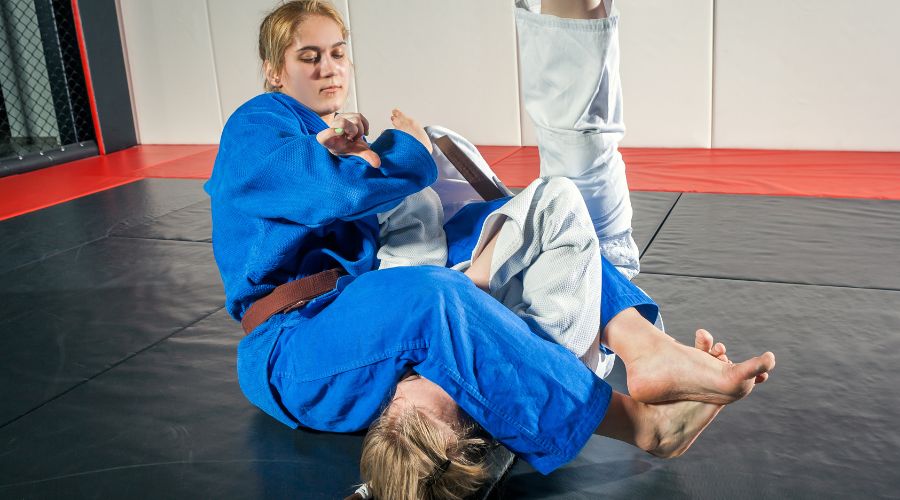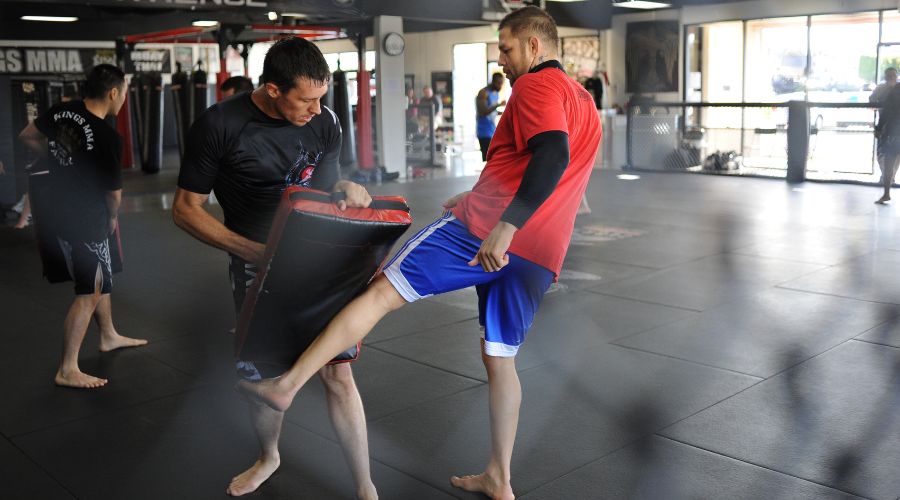BJJ has become the world’s premier grappling system, and chokes and joint locks are its specialties, not punches and kicks. BJJ is most well-known as a sport, but modern competitions are not the entirety of the martial art. So does BJJ have striking?
BJJ is a grappling martial art and does not have any striking. But this is only the popular sports version of BJJ. In contrast, the traditional self-defense version has both defenses against strikes and some limited use of palm strikes, elbows, and kicks used for defense or a setup for grappling.
BJJ comes from traditional Japanese jiu-jitsu and today has a few iterations, from sports BJJ to self-defense BJJ to Combat BJJ. While each is focused on grappling, the relationship to striking varies from style to style.
Does BJJ Have Striking
To have a complete answer, we must look at all the different types of BJJ separately and see what strikes are in each.
Self-Defense BJJ
The Gracie family in Brazil created Brazilian jiu-jitsu, and the traditional form is often called Gracie BJJ. They created the martial art entirely to be a reliable and effective self-defense system. As such, it had to also include some form of striking. Helio Gracie, who created Brazilian jiu-jitsu along with his brothers, was smaller and lighter than most of his peers.
He had to find a way to defeat his opponents using technique, leverage, and positioning on the ground, where size matters less. But a complete system for self-defense or no-rules fights needs to have an answer to strikes, and traditional BJJ has always had in mind.
In self-defense BJJ, the main focus is still grappling, but there is also a defense against common strikes and ways to close the distance. Old-school classes include defending against straight punches, hooks, haymakers, and some kicks.
Before using submissions, you also need to be able to safely tangle an attacker, prevent him from punching or head-butting, and then take him to the ground.
Then there are even some strikes used for an attack in self-defense BJJ. These are usually short, but hard palm or elbow strikes to the head. Helio and his family created the original system also included fast kicks to the thigh or the knee, similar to what is today known as the oblique kick.
These short strikes serve to stop an opponent, gauge distance, or distract them for your own entry. These techniques can be seen in the Gracie Challenge matches caught on tape and in the Vale Tudo and MMA fights of Rickson Gracie.
So while traditional Gracie BJJ focuses heavily on grappling, some simple, striking offense and defense are included. Rener Gracie, the grandson of Helio Gracie, famously said, “If you are not training Jiu-Jitsu using strikes, then you are not doing Gracie Jiu-Jitsu. BJJ with strikes isn’t MMA, it’s Gracie Jiu-Jitsu”.
Sports BJJ

In sports BJJ, all strikes are strictly forbidden and are a quick way to get disqualified. Sports BJJ is a strictly grappling martial art, to the extent that takedowns and throws are not heavily rewarded in competition like in other grappling sports like judo and wrestling.
The game of BJJ is played on the ground, and it’s all about passing guards, sweeps, and submissions. This creates an entirely different dynamic from what grappling looks like when there are strikes allowed.
Because modern BJJ is the most popular version of jiu-jitsu, the widespread opinion is that BJJ does not have any striking. But this is true only as far as the sport’s rules go. However, it is also true that most academies only teach sport BJJ and do not teach self-defense or MMA, meaning no striking.
Traditional Jiu-Jitsu
Traditional jiu-jitsu came from Japan and was created and developed as a fighting system for real life. As such, it covered all elements of fighting, including striking.
Jiu-jitsu was first created for unarmed or light weapon combat against armored opponents. Strikes are ineffective against armor, so the main techniques were throws, pins, disarms, chokes, and joint locks.
Then in the Edo period, jiu-jitsu was picked up by the samurai cast and evolved to include more striking elements. There have been many different jiu-jitsu styles over the centuries. The term is a catch-all for many grappling-based styles with varying degrees of striking.
Combat BJJ
The most modern version of BJJ is the creation of Eddie Bravo, called Combat BJJ. Combat BJJ is a hybrid form of jiu-jitsu that allows open-handed strikes on the ground, borrowing an element from MMA. These strikes dramatically change the ground game and can even be used to win the match.
The Combat BJJ League was created in 2013. Still, the idea of having open-hand strikes is nothing new. It has been used in Gracie BJJ since its very beginning, with slaps and palm strikes often in the arsenal of fighters taking part in the Gracie Challenges.
With the rise of sports BJJ, jiu-jitsu became increasingly less realistic for self-defense and MMA. The introduction of Combat BJJ was Eddie Bravo’s answer to some of the more ridiculous sports moves and tactics.
The addition of strikes, even only on the ground, returns BJJ closer to what it was initially meant to be. A comprehensive self-defense system capable of winning a real fight.
Overall, Combat BJJ rules are much more liberal than the increasingly restrictive rule book of sports BJJ. Aside from open hand strikes to the head and body while the fighters are on the ground, there is no points system, and a match can be won by submission, TKO caused by hand strikes, or overtime rules.
There are also no restrictions on the submissions that you can use. The strikes in Combat BJJ are not there to make BJJ more like MMA but to make it more realistic and abolish some of the stall tactics often employed in sports BJJ.
Combining BJJ and Striking

BJJ may represent the best of grappling, but this is only one side of the coin called fighting, and the other side is striking. Today, there is so much proof that a complete fighter must have skills in both striking and grappling that there are barely any martial artists left that don’t recognize this fact.
The rise of MMA has been the primary catalyst in this paradigm shift in understanding how complete martial arts should look. BJJ has influenced early MMA development more than any other discipline. Still, it is also clear that when people learn basic ground fighting and defense, BJJ is not enough.
Striking and grappling are not mutually exclusive but complement each other beautifully. Martial arts like Kudo and Combat Sambo are good examples of that aside from MMA. Striking is very good as a setup for grappling.
Punches and kicks are a great way to occupy the opponent’s attention and close the distance to take him down. Once on the ground, striking again serves as a way to open up the opponent for a submission that he would defend if not punched in the face.
Conversely, understanding how to manipulate the ground positions and obtain different guards will allow you to execute ground strikes much better. Threatening with a submission may also open up new opportunities for ground and pound.
Separating grappling and striking creates a high level of specialization. It pushes the boundaries of both, but only their combination can be called complete martial arts.
Is BJJ Striking Or Grappling?
BJJ has always been a highly specialized grappling system of fighting used to control, dominate, and submit an opponent on the ground. With that said, BJJ was created for self-defense and no-rules fighting, and in its traditional version, it teaches defense against punches and kicks, as well as their use to gauge distance and enter into grappling range.
Despite that, BJJ is considered a grappling martial art with very limited striking, which is absent from the sports version of the sport.
